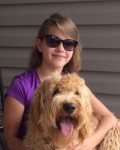Here is a fun little article on transforming your puppy. As many of you may know that Ashford Manor Labradoodles works hard with your puppy everyday before they come to your home. Your puppy is well on its way to leash walking, potty training, and sleeping in their crate. Once they join your family things are a little different – smells, people, commands, and the environment. Find out how to make things a little easier in this article.
HOW CAN YOUR WILD PUPPY BECOME
YOUR BRILLIANT FAMILY DOG?
 You’ve decided now is the time to get a dog for your family. Excitement is running high! Expectations are through the roof. Plans are being laid.
You’ve decided now is the time to get a dog for your family. Excitement is running high! Expectations are through the roof. Plans are being laid.
But how realistic are these expectations? How near to reality are the plans?
I find that new puppy-owners tend to fall into two camps – those who expect too much too soon, and those who expect too little for too long. Let’s have a look at this more closely:
1. Expecting too much too soon
When you get your puppy at seven or eight weeks old, he is a baby. His eyes have only been open for six weeks. Everything is new to him – everything. He has to learn to trust you as his guardian and protector first. So shouting SIT SIT SIT at him is mystifying and frightening! There will be plenty of time for learning to sit on cue – but there’s only a short time for so much else that needs to be learnt first.
We have very short memories (why do women give birth to more than one child? If they remembered what they went through the first time they probably wouldn’t!) So remembering how good our old dog was is not helpful. What you’re probably remembering is when he was twelve and fitted your home comfortably like an old pair of slippers. You’ll have forgotten the mayhem and mess of his early weeks and months. Perhaps your old dog grew up in a noisy, busy family, with endless entertainment and learning. Now your home is quieter, but your pup will need the same level of stimulation and novelty.
2. Expecting too little for too long
Then there are those who appreciate that their puppy is a baby – but forget that their development is many times faster than that of a human infant. A pup of six months is something similar to a child of twelve years old in terms of maturity. You have a lot to pack in those first four months with you!
Fortunately young puppies are sponges. They soak up learning. It’s so easy to teach them what you want before they’ve discovered what they want. And like children, they accept the status quo. If feeding is always done in their crate followed immediately by a visit to the garden, this will be the accepted pattern which they will put on autopilot.
It used to be thought that puppies couldn’t start training until they were six months old or more. Imagine teaching absolutely nothing to your child until he reached twelve! The mind truly boggles at what you’d be up against. But with the revelation that force-free training is quicker and more efficient than traditional punitive methods, and that it develops an unbreakable bond between dog and owner, puppy training can start at around five weeks. The pup is still in the litter, of course, but he’s learning! This is where the importance of a conscientious and knowledgeable breeder comes in. Why not let him learn early on that people are good news and interacting with them is to his advantage?
Trainers in the vanguard of scientific thought do much of their teaching through games – every game designed to achieve one key skill. You want to find one of those excellent, thoughtful, kind trainers for your puppy!
4. All things to all men?
Your dog can’t be everything. He can’t fulfil all the roles that dogs are able to perform. Each dog is an individual. He may be unsuited to some activities, sports, ways of life, on account of his size or conformation. He may be temperamentally unsuited: he may be a social butterfly – or he may be a party pooper. While you can improve his perception of the world, tempering his excesses and building his confidence, you have to accept that maybe this dog won’t be your world class agility dog; maybe not the one to go on transalpine treks; perhaps not a cuddly lapdog or people-pleaser.
You can load the dice in your favour by researching your chosen breed and breeder minutely before you make your choice. But there’s still an element of the “luck of the draw”. How many people do you know who are quite unlike their parents? Your challenge will be to find where your dog does shine and develop that to his fullest potential.
5. Give time for the bond to grow
As you go through the early weeks and months, there’s no place for frustration or loss of temper, which will serve only to damage your relationship with your dog. Your puppy is not doing what he does out of stubbornness, naughtiness, defiance. He’s doing it because he’s a dog. And you haven’t yet shown him what you’d like him to do instead.
Punishment rewards the punisher – makes them feel better, more in control through having lost control. It doesn’t help the one who is punished. It makes them evasive, resentful, untrusting. It won’t change their behaviour – they’ll just make sure you’re not around when they do it. Confusion reigns: think of the puppy who is told off for weeing in the house (who’s in charge of the feeding schedule and the doors here?) then makes sure to leave his next puddle behind the sofa where you can’t catch him and chastise him again.
Give your dog the time he needs to learn with you. Your days were already full before your puppy arrived, so you have to make time. Give him time – and undiluted, focussed attention. This is especially important when you already have a dog in the household. Your puppy needs that individual attention you lavished on your first dog if he’s to develop the same bond with you.
7. Expand your dog’s mind
Brainwork – as we all know! – is tiring. Use up some of that boundless energy by getting your puppy to think, to make choices, to assess situations and make good decisions. In order to think and choose, we have to have the freedom to make mistakes. Encourage and welcome those mistakes, which show that your dog is thinking and trying things. Choice-based training means that when your dog makes a poor choice nothing happens, good or bad. When he makes a good choice he gets excitement, treats, games, fun. Which do you think he’s going to choose again?
8. Don’t forget to enjoy your puppy!
Remember why you wanted a dog in the first place. Don’t get bogged down by worrying about whether your puppy is learning quickly enough, whether he’s showing you up at puppy class, whether you look inadequate if he doesn’t come when he’s called. Take the broader view and see it as a giant learning curve for both of you. Enjoy this time – it speeds past!
Find out how to avoid some of the pitfalls of early training at www.brilliantfamilydog.com
Cheryl Sabens
Ashford Manor Labradoodles
Breeder of the Australian Labradoodle in mini, medium, and standard sizes
765-714-1436



Recent Comments